Biggest crane in the world: The LTM 11200 is the largest mobile crane in the world, manufactured by the German giant of heavy machinery, Liebherr Group.
This type of cranes is used in construction, general civil works of great magnitudes, such as the construction of a viaduct, although they can also act in private works such as the repair of a skyscraper.
Habitually, a quite common use is the maintenance and repair of large wind towers.

Biggest crane in the world
Biggest Liebherr crane:
The Liebherr LTM 11200-9.1, built by the German company Liebherr Group, is the most powerful mobile crane ever built. It also has the longest telescopic boom in the world, which extends fully to 100 meters. It’s set on a double cab truck and can lift 1200 metric tons – that’s nearly 700 automobiles. That’s real pound-for-pound power for its category, but ultimately not the strongest crane in the world when compared to stationary cranes.
Crane data sheet
- The maximum load capacity is 1200 tons at a distance of 2.5 meters from the axis of rotation and 202 tons of ballast.
- The load capacity of 65t in braced telescopic boom 100 m long
- The crane is equipped with four telescopic hydraulic supports that are supported on the ground to ensure stability.
- The mobile crane weighs 108 tons, is 3 meters wide, 20 feet long closed.
- Officially, this crane was presented in April 2007 at Bauma, the world trade fair for construction machinery.
- The axles have a system in which all the wheels rotate and the crane can easily become a tight place.
- The chassis has 9 axles with a newly developed rear axle.
- Telescopic boom 100 m in length and extensions of 22 m telescopic boom (10 m + 6 m + 6 m)
- Folding nib 126 m long
- Fixed nib 60.5 m long, optionally hydraulically adjustable
- Quick and comfortable assembly in small spaces
- Optimal for assemblies in the industry, in wind energy and for infrastructure works
- Rear direction active as a function of speed, all axes addressable
- Economic transport
Now you know a little more about this powerful construction machinery.
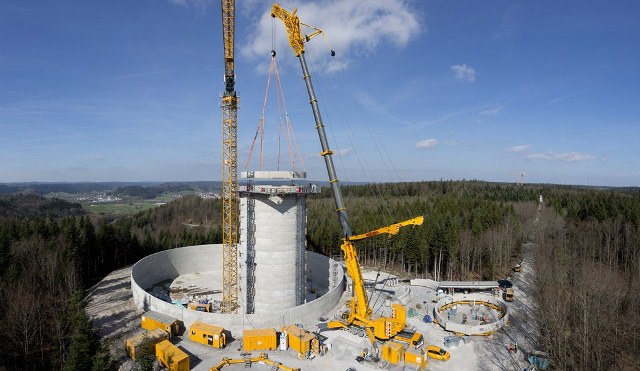
Crane specification
The chassis moves with the superstructure, lifting cylinder and four support beams folding on the road.
The weight of the vehicle and the axle weights can be reduced by disassembling the equipment. The pen is transported separately in a gondola. For this, there are different possibilities.
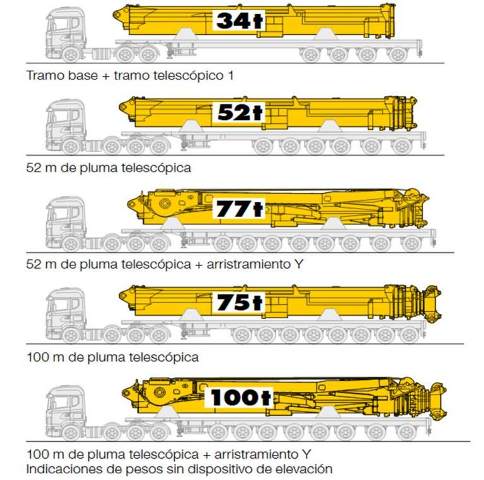
Biggest mobile crane in the world
A multitude of works of cranes of great capacities can be realized with few vehicles of transport.
For the assembly of a wind turbine with a rotor center height of 80 m and individual weights of up to 80 t, only 4 transport units are required:
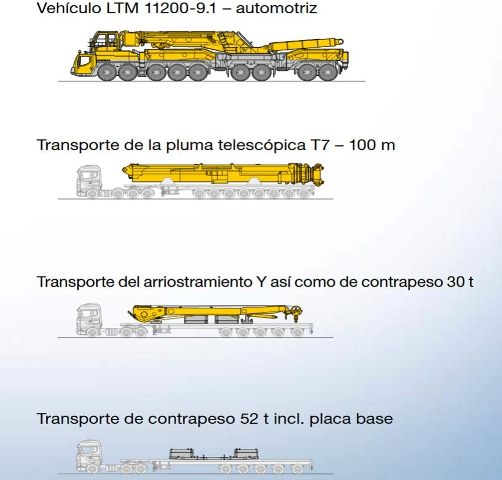
Crane counterweight
The concept of counterweights of the LTM 11200-9.1 developed by Liebherr offers multiple advantages for the crane.
- Dimensions and weights of the counterweight plates are optimally adjusted to the gondola
- Complete assembly of counterweights without an auxiliary crane
- High profitability thanks to the compatibility of the counterweights with those of other large capacity Liebherr cranes
- Comfortable and safe counterweight assembly with the control unit and BTT function console
- Motherboard 22 t
- 16 identical plates of 10t each 160 t
- 4 identical plates of 5t each 20 t
- Total weight 202T
Thanks to the low working height due to the extensive distribution of the counterweights in two piles on each side, greater safety and ergonomic working conditions are obtained.
Crane system
Transfer system:
- Hydropneumatic suspension
- Maintenance-free suspension cylinders
- Large dimensions to support high axle weights
- Suspension travel + 175 / -125 mm
- High stability in curves
- Choice of the translation program through fixed selection programs
- Disc brakes
- High breaking capacity, better dosage
- Improved stability in the braking line
- No loss in brake efficiency through higher temperatures (fading)
- Long useful life
- Change of pads fast and easy
- Brake pads with wear indicator
- electric brake
- No wear, system requiring little maintenance
- More security thanks to the quick activation in thousands of seconds
- Reduction of operating costs
- High comfort thanks to absolutely jerk-free brakes
- Ecological brake system, free of emissions and particles
- Chassis engine
- Powerful 8-cylinder turbodiesel engine with 500 kW / 680 PS, max. 3.000 Nm
- 12-speed automatic gearbox system ZF-TC-TRONIC with converter, next to the gearbox offers high profitability and the best comfort.
- Axes 1, 2, 4 and 5 are addressable axes
Motor crane
- Liebherr 6-cylinder turbodiesel engine, 270 kW / 367 PS, max. 1,720 Nm
- Optimal fuel consumption through electronic engine management
Crane cabin
Comfort and functionality:
- Both the modern driver’s cab and the mobile operator’s cab have a comfortable and functional arrangement of the elements.
- The control and command elements are located according to ergonomic criteria.
- In this way a safe and fatigue free place is guaranteed.
Driver’s cabin
- Resistant to corrosion
- Panoramic safety glazing
- Tinted windows
- External mirrors heated and electrically regulated
- Driver’s seat with air suspension with lumbar and vertebral support
- Additional heating independent of the motor, Air Conditioning
Crane cab
- Optimized heating and ventilation system, automatic temperature regulator, additional independent motor heating, air conditioning
- Wide visual field thanks to large moons
- Driver’s seat with lumbar and vertebral support, adjustable with multiple options
- Folding 20º backward
- The cab can be lowered hydraulically for more comfortable access
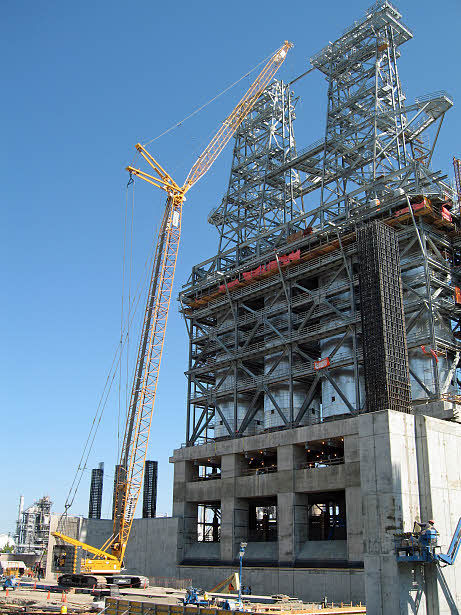
world’s largest mobile crane
Load moment indicator
Safe Load Indicating Systems for mobile cranes have been in existence for over 50 years. Over the past 20 years, as technology has progressed, devices capable of measuring load moment have become very widely used on many types of cranes on a worldwide basis. Despite this prevalence, there exists a number of misconceptions about what load moment is and its importance for monitoring the capacity of cranes.
The term load moment is an engineering term which refers to the product of a force and its moment arm. The moment arm is defined as a perpendicular distance between the force vector and a reference point as shown below. In the case of cranes, the force acts vertically through the center of gravity of the load and the moment arm becomes the horizontal distance from this center of gravity of the load and the center of rotation of the crane.
Therefore, with a one thousand unit force acting at a ten unit radius, the load moment is the product of these two factors or ten thousand units as shown below.
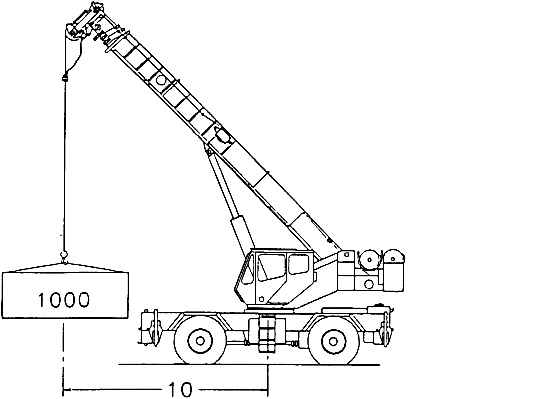
If we increase the radius such that this load acts upon a twenty unit radius, the load moment has increased to twenty thousand units
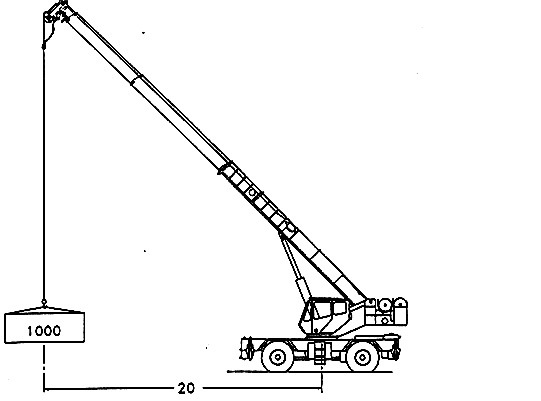
Load moment indicator crane
In this example, the load on the load line has remained the same but the load on the crane, the load moment, has actually increased by a factor of two. Because load moment is used to determine the capacity of a crane, crane load charts require the operator to determine not only the magnitude of the load but the radius that the load is acting upon. Since load, the moment is a product of these two each value becomes equally important
In the past crane operators often relied on “feel” to determine when the crane was reaching capacity. By working from “the seat of his pants” the operator felt the load on the outriggers lighten and knew he was reaching the stability limits of his machine.
He was in effect using the stability of the machine to indicate load moment. In the past, the cranes were very heavily constructed with the consequence that the structural capacity far exceeded the stability limits of the machine.
Load moment indicator for mobile crane
Now the emphasis is on reach and readability and the manufacturers have utilized higher yield steels to create the stronger and lighter cranes. This has had two effects.
- The structurally limited portion of the load charts has increased. This is the first portion of the load chart where a structural failure can occur before the stability limits are reached. In some cases, this can encompass the entire chart for the main boom. A failure in this area can be sudden and with little or no warning.
- The second effect is that by utilizing lighter booms with more elastic steels boom deflection has increased dramatically. This is extremely important because as the boom deflects under an actual load it increases the load radius.
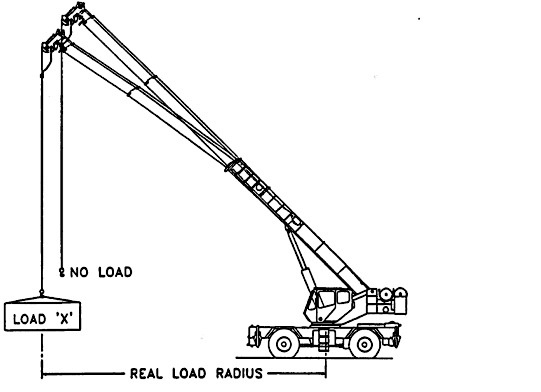
This increases the load moment proportionately. An increase in the radius of 15% has increased the load on the crane by 15%. It is extremely important that the operator be aware of these dynamic changes affecting the crane.
In a job site situation, the operator may not know the true magnitude of the load. It may have been frozen to the ground or may have taken on water. Once determined this is only half the equation. Just as importantly, he does know the final load radius. It is impractical to physically measure this new load radius because the true load radius is not achieved until the pick is already made.
What is the load moment?
Therefore, it is imperative that the operator not only be aware of the load on the hook but also of his true load radius, dynamically, as he increases the load on the boom. This is the distinct advantage of a load moment system.
A load moment system, by monitoring load moment and by compensating for the true deflection under load can give an operator an indication of exactly where he is on the load chart of the machine. If only the hook block load is monitored the true load on the boom and its effects on radius are not considered.
Conventional Lattice Boom Cranes work under a different principle which results in reducing the impact of deflection.
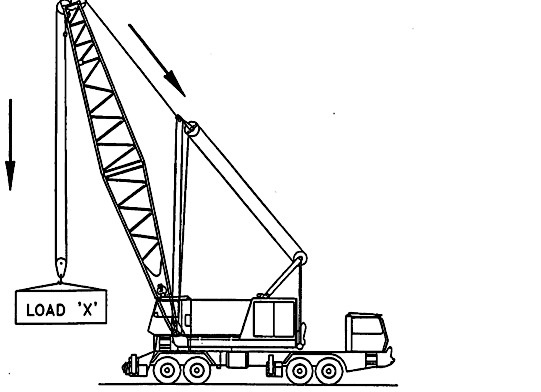
Crane load indicator system
As shown above, the pendant ropes supporting the boom tip create an offsetting force with the resulting load aligned in the plans of the boom. The boom in a conventional cane, therefore, is in compression behaving more as a column.
Generally, total deflection has much less impact upon radius than it does with telescopic cranes. There are still, however, great advantages to a load moment system on a conventional crane. By monitoring the forces in the boom hoist structure, the system can monitor the load on hook, the boom weight, and any dynamic forces on the boom. In the case of large conventional machines additional forces such as icing, wind, load dynamics, etc. can have a significant impact on capacity.
Load moment systems, as with most crane indicating systems, are considered operators aids. The intent is always to provide the operator with as much relevant information as possible to enable hirn/her to perform their duties in the safest and efficient manner possible. Ultimately, however, it is the operator that makes the difference. A well trained and experienced operator utilizing well-maintained equipment with state of the art operator aids is the best assurance that the lift operations will be conducted safely and efficiently.
Who owns the biggest crane in the world?
The Liebherr LTM 11200-9.1, built by the German company Liebherr Group, is the most powerful mobile crane ever built. It also has the longest telescopic boom in the world, which extends fully to 100 meters. It’s set on a double cab truck and can lift 1200 metric tons – that’s nearly 700 automobiles.
Liebherr is the 20th-largest Swiss company by revenue (8 270 million Swiss francs). The top 10 Swiss companies by revenue are Glencore, Nestlé, Novartis, Roche, ABB, Adecco, Migros, Holcim, Cargill International SA, Coop.
The maximum load that the crane can lift is 18 metric tons, but the crane cannot lift that much weight if the load is positioned at the end of the jib. The closer the load is positioned to the mast, the more weight the crane can lift safely.
Costain has used the UK’s largest mobile crane to install the main deck girders for the Clydach River Bridge. The bridge, located in Saleyard, is part of the Heads of the Valleys project to create a dual carriageway on the A465
Hydraulic truck cranes vary in lifting power. It’s easy to tell how much a particular hydraulic truck crane can lift just by the name of it: A 40-ton crane can lift 40 short tons (80,000 pounds or 36,287 kilograms).
Boom angle indicators are normally mounted on the boom butt, visually readable by the operator. On most models in the NCF, the boom angle indicator is a metal plate with degree numbers (0 to 90 degrees) and a freely swinging arm that reacts as the boom angle changes.
The most read
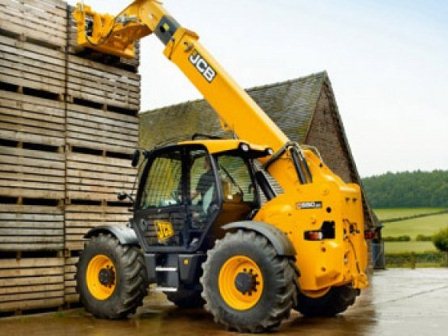
Telehandler Forklifts
A telehandler handler, also known as a telescopic handler, telehandler, teleporter or rough terrain forklift, is a vehicle with a telescopically extensible boom, which can extend forwards and upwards from the vehicle, so it can be fitted with various lifting.

Telescoping Boom Lift
Traditionally, the telescoping system consisted of as many extension cylinders as the displaceable sections had the boom of the telescopic crane. This gave the crane great flexibility of movements with the counterpart of excessively increasing the weight of the pen itself.
